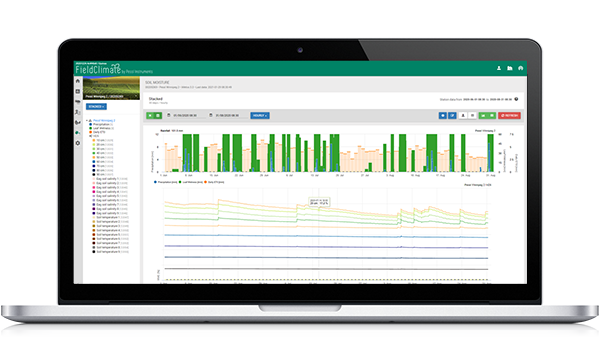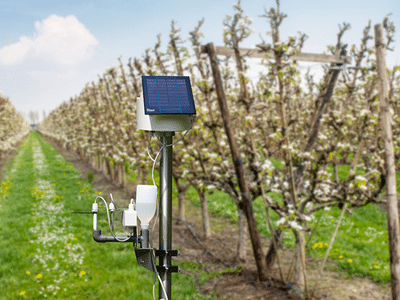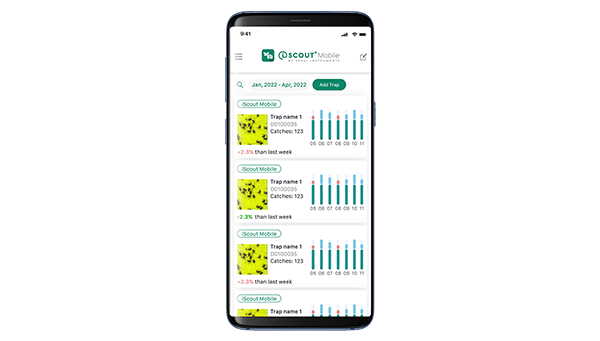

Onion disease models
Onion diseases can cause severe losses by reducing yield and quality of marketable onions. There are diseases affecting the root and diseases affecting the leaves and the upper part of the bulb. Our models are based on weather data, which are mainly influencing diseases affecting the aerial part of the onion.
Downy Mildew
Downy mildew (Peronospora destructor) attacks onions in many parts of the world. It can become severe on leaves of commercially grown onion plants and on leaves and seed stalks of onions grown for seed, especially when relatively cool, moist weather prevails. Other reported hosts are shallot, leek, garlic, and chive.
Symptoms and economic impact
Downy mildew is characterized by pale green, yellowish to brownish areas of oval to cylindrical size and shape on infected leaves or seed stalks. These areas may consist of alternating yellow and green layers of tissue. The causal organism of Downy Mildew produces fruiting bodies and spores called sporangia on the surface of the leaves and seed stalks. The masses of spores are at first transparent to greyish, and then rapidly become violet in color. Leaves become girdled in the region where mildew develops and the leaves collapse. This results in dead leaf tips that usually can be seen within defined regions in a field. The dead leaf tissue is rapidly colonized by purple blotch, which is dark in color. Downy Mildew seldom kills onion plants, but bulb growth may be reduced. Bulb tissue, especially the neck, may become spongy and the bulb may lack keeping quality.
Biology of Peronospora destructor
Dormant Period: It is believed that the Downy Mildew fungus overwinters primarily as mycelium in infected onions that remain in onion fields or in nearby cull piles. The pathogen also can overwinter in perennial varieties of onion in home gardens.
Infection: Spores are formed on systemically infected material form the last year or on mature lesions from the actual season at night when high humidity and temperatures of 4–25 C occur, with an optimal temperature of 13°C. The spores mature early in the morning and are disseminated during the day. Spores remain viable for about 4 days. Germination occurs in free water from 1–28 °C with an optimal range of 7–16 °C. Rain is not needed for infection if heavy dews occur continuously during the night and morning hours.
Incubation Period: The mycelium of Downy Mildew in leaves of infected onion plants in commercial bulb production fields produces a new crop of spores called conidia in cycles of approximately 11–15 days.
Milioncast – Peronospora destructor Model
Sporulation: The greatest number of sporangia was produced at 100% relative humidity (RH), and sporulation decreased to almost null when humidity decreased to 93% Rh (modeling: about 4800°minutes needed for 100% sporulation; increase of infection: average degree /hour * 60/ degreeminutes needed).
Infection: Downy mildew spores require temperatures between 6 to 32°C and anywhere between 4 to10 hours of leaf wetness to germinate. Spores survive 1- 3 days after sporulation, free water has to be available.
Incubation Period: The mycelium of Downy Mildew in leaves of infected onion plants in commercial bulb production fields produces a new crop of spores called conidia in cycles of approximately 11–15 days.
In FieldClimate:
1.) Sporangia are produced during darkness and calculated if leaf wetness >0 and temperature between 6 and 24°C
2) If Sporangia are there and additional precipitation the infection starts to be calculated (also between a temperature regime of 6-24°C).
3) If infection is 100% we had optimal conditions for the fungal pathogen to infect the plant and so the incubation starts to calculate the time between infection and first symptoms will be seen in the field.
Botrytis leaf blight
Botrytis leaf blight (Botrytis squamosa) is a fungal disease that occurs in many of the onion growing areas of the world. The causal organism, Botrytis squamosa, causes leaf spots (lesions) and maceration of leaf tissue resulting in leaf dieback and blighting. The lesions are whitish in color, from 1-5mm in length, and most are surrounded by greenish-white halos that appear water-soaked when first formed. The centers of the lesions usually become sunken, straw colored, and may develop a characteristic slit that is oriented lengthwise in the lesion. Older onion leaves are more susceptible than younger leaves to lesion formation and blighting. Under favorable environmental conditions (high rainfall, extended periods of leaf wetness, high relative humidity, and moderately warm temperatures 9°C – 25°C), Botrytis Leaf Blight can result in reduced onion bulb growth and yield.
Botrytis Leaf Blight Infection
Some infection can occur with only seven hours of leaf wetness if temperatures are near the optimum range of 15°C to 20°C. As temperatures deviate from this optimum range, longer periods of leaf wetness are required for infection. For example, temperatures at 9°C and 26°C are conducive to infection, provided that leaf wetness periods increase to 10 hours. Levels of infection should be regarded as being most severe if leaf wetness periods approach 14 hours, provided that temperatures are in the optimum range. Severe levels of infection can also occur at 9°C and 26°C if leaf wetness periods last for nearly 20 hours.
Decision should be made in combination with a method of forecasting the presence of significant amounts of inoculum of B. squamosa. The presence of inoculum depends on the age of the culture in the field and observed symptoms before.
The Botrytis Leaf Blight (Botrytis squamosa) Infection Model used by FieldClimate points out Infections and severity. An infection of the weakest severity is fullfilled after the minimum time needed for spore germination and infection. As longer the leaf wetness will persist as more spores will participate in the infection.
In FieldClimate we calculate 4 Severity levels:
1) insignificant
2) slight
3) moderate
4) severe potential infection periods.
Botrytis leaf spot
Botrytis Leaf Spot is caused by the pathogen Botrytis cinerea. B. cinerea has a very vide host range and is present in every farming or gardening environment. White sunken spots on leaves are usually the first sign of infection; spots are small (0.5 mm up to 6 mm long) and tend to be oval. They sometimes have a light green halo and may appear water soaked. The epidermis around the spots may be silvery. When numerous spots are present, leaf tips die back and whole leaves may be killed. B. cinerea spores land on leaf surfaces and, in the presence of moisture, germinate and produce enzymes that kill leaf tissue. The fungus damages the leaf by causing leaf spotting. Leaf surfaces must be wet by dew or rain for long periods (20 or more hours) for leaf spot to develop. Optimum temperature for germination of spores is 15°C; optimum temperature for mycelial growth is 18°C to 25°C.
Botrytis Leaf Spot Risk Model: B. cinerea infections are related to free moisture. In open field production leaf wetness is a good indicator for this. Dry days will reduce the risk again.
Stemphylium leaf blight
Stemphylium leaf blight is caused by the fungus Stemphylium vesicarium. Small, light yellow to brown and water-soaked lesions develop on leaves. These small lesions grow into elongated spots that frequently coalesce resulting in blighted leaves. Lesions usually turn light brown to tan at the center and later dark olive brown to black as the spores of this pathogen develop. S. vesicarium normally invades dead and dying onion tissue, such as leaf tips, purple blotch and downy mildew lesions, injured tissue, and senescent tissue. Infection usually remains restricted to leaves and does not extend into the bulb scales. Lesions generally occur on the side of the leaf facing the prevailing wind. Long periods of warm wet conditions encourage disease development.
Stemphylium versicarium model is based on the work of SUHERI and PRICE in onions and LLorent, VILARDELL, BUGIANI, GHERARDI and MONTESINO in pear. Infection curves for weak, moderate and severe infections are computed. It depends on the disease history of the location wheather a treatment has to be taken into consideration by a weak, moderate or heavy infection.
With this separation into favourable, moderate favourable and very favourable situations it is up to the grower to decide how big the disease pressure in a specific field will be and if he has to cover a specific infection.
Temperature: 11-30°C
Leaf wetness: > 0 (start for infection) or rel. humidity > 90% (just if there was already an infection before calculated and is still holding)
Light infection (11-30°C), moderate infection (13-30°C), severe infection (16-30°C), array with leaf wetness duration (see above).
Reset: if rel. humidity is lower than 70%.
S. versicarium infections exists often together with Alternaria porri infections. Therefore the TomCast (Alternaria) model is quite frequently used for both.
Purple blotch
Downy mildew (Peronospora destructor) attacks onions in many parts of the world. It can become severe on leaves of commercially grown onion plants and on leaves and seed stalks of onions grown for seed, especially when relatively cool, moist weather prevails. Other reported hosts are shallot, leek, garlic, and chive.
Symptoms
Purple blotch symptoms are first observed as small, elliptical, tan lesions that often turn purplish-brown. Concentric rings can be seen in lesions as they enlarge. A yellow halo surrounds lesions and extends above and below the actual lesion itself for some distance. Lesions usually girdle leaves, causing them to fall over. Lesions may also start at the tips of older leaves.
Model TomCast
Purple blotch and Tom Cast: TOMCAST is derived from the original F.A.S.T. (Forecasting Alternaria solani on Tomatoes) model developed by Dr. Madden, Pennypacker, and MacNab at Pennsylvania State University (PSU). The PSU F.A.S.T. model was further modified by Dr. Pitblado at the Ridgetown College in Ontario into what we now recognize as the TOMCAST model.
A Disease Severity Value (DSV) is the unit of measure given to a specific increment of disease (early blight) development. The use of the DSV: A DSV is a numerical representation of how fast or slow disease (early blight) is accumulating in a field. The DSV is determined by two factors; leaf wetness and temperature during the “leaf wet” hours. As the number of leaf wet hours and temperature increases, DSV accumulate at a faster rate. Conversely, when there are fewer leaf wet hours and the temperature is lower, DSV accumulate slowly if at all. When the total number of accumulated DSV exceeds a present limit, called the spray interval or threshold, a fungicide spray is recommended to protect the foliage and fruit from disease development.
The spray interval (which determines when you should spray) can range between 15-20 DSV. The exact DSV a grower should use is usually supplied by the processor and depends on the fruit quality and end use of the tomatoes. Following a 15 DSV spray interval is a conservative use of the TOMCAST system, meaning you will spray more often than a grower who uses a 19 DSV spray interval with the TOMCAST system. The tradeoff is in the number of sprays applied during the season and the potential for difference in fruit quality.
Recommended equipment
Check which sensor set is needed for monitoring this crop’s potential diseases.




